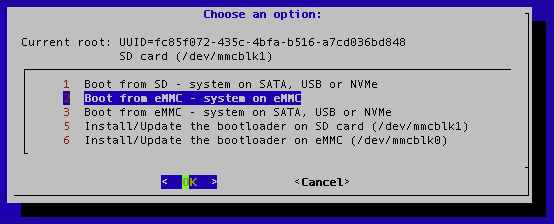
Meestor_X
Members-
Posts
91 -
Joined
-
Last visited
Content Type
Forums
Store
Crowdfunding
Applications
Events
Raffles
Community Map
Everything posted by Meestor_X
-
Maybe not? root@rp-satellite-01:~# for X in 0 1;do echo "mmcblk${X}: $(cat /sys/block/mmcblk${X}/device/type)";done mmcblk0: SD mmcblk1: SD root@rp-satellite-01:~# lsblk NAME MAJ:MIN RM SIZE RO TYPE MOUNTPOINTS sdb 8:16 1 238.3G 0 disk └─sdb1 8:17 1 238.3G 0 part /media/usb mmcblk1 179:0 0 59.6G 0 disk └─mmcblk1p1 179:1 0 59G 0 part /var/log.hdd / mmcblk0 179:32 0 3.6G 0 disk └─mmcblk0p1 179:33 0 3.5G 0 part zram0 252:0 0 233.1M 0 disk [SWAP] zram1 252:1 0 50M 0 disk /var/log zram2 252:2 0 0B 0 disk root@rp-satellite-01:~#
-
Ok, I only use this utility on Radxa products ATM, and AFAIK they can't boot from USB without a bootloader on the eMMC or SD card. If I had an image on a USB flash drive attached to the SBC, where would armbian-install expect to find it mounted? And then, would choice #1 or #3 use the SD card or the USB image? Also, should option #2 not show? I don't know how it would copy from the eMMC to the eMMC... The operation of the script works well, but the menu could be much clearer for the Radxa products.
-
df -h Filesystem Size Used Avail Use% Mounted on udev 159M 0 159M 0% /dev tmpfs 47M 4.8M 42M 11% /run /dev/mmcblk1p1 58G 3.4G 53G 7% / tmpfs 234M 76K 233M 1% /dev/shm tmpfs 5.0M 0 5.0M 0% /run/lock tmpfs 234M 4.0K 234M 1% /tmp /dev/zram1 47M 2.4M 42M 6% /var/log /dev/mmcblk0p1 3.4G 2.0G 1.3G 62% /media/emmc tmpfs 47M 0 47M 0% /run/user/0 lsblk NAME MAJ:MIN RM SIZE RO TYPE MOUNTPOINTS mmcblk1 179:0 0 59.6G 0 disk └─mmcblk1p1 179:1 0 59G 0 part /var/log.hdd / mmcblk0 179:32 0 3.6G 0 disk └─mmcblk0p1 179:33 0 3.5G 0 part /media/emmc zram0 252:0 0 233.1M 0 disk [SWAP] zram1 252:1 0 50M 0 disk /var/log zram2 252:2 0 0B 0 disk lsb_release -a No LSB modules are available. Distributor ID: Debian Description: Armbian 25.8.1 bookworm Release: 12 Codename: bookworm uname -r 6.12.44-current-rockchip64 I don't have an easy way to do the serial terminal thing to check U-Boot. I have updated it to the "latest" using armbian-install, however...
-
Can someone explain these lines? # find real mmcblk device numbered 0, 1, 2 for eMMC, SD for ret in $(find /dev -name 'mmcblk[0-2]' -and -type b) do if [ -b ${ret}boot0 ];then emmc_dev=$ret else sd_dev=$ret fi done On the RockPi-S, $ret would equal mmcblk0 and mmcblk1 which are the eMMC and SD card, respectively. There's no device called "mmcblk0boot0" or "mmcblk1boot0".
-
Coming back to this... I'm not having any luck getting overlays to work, but I'll need to get out my serial logger to see what's wrong I guess. I'm trying to get the USB-C into host mode on my RockPi-S. I can do it by editing the rk3308-rock-pi-s.dtb file directly, but not using an overlay file. Here's the overlay file I've tried (usbc-host.dts): /dts-v1/; / { fragment@0 { target-path = "/usb@ff400000"; __overlay__ { dr_mode = "host"; }; }; }; and /dts-v1/; /plugin/; / { fragment@0 { target-path = "/usb@ff400000"; __overlay__ { dr_mode = "host"; }; }; }; Tried using: armbian-add-overlay usbc-host.dts as well as compiling the overlay to a .dtbo and adding the line directly into armbianEnv.txt No joy either way... Also, does anyone know why some .dtbo files also have the line /plugin/; below /dts-v1/; ?
-

Audio no longer works after updating to Armbian 24.8.2
Meestor_X replied to PHLAK's topic in Radxa Rock Pi S
Ok, this is weird (or maybe expected, I'm a newbie to all of this)... I installed fresh 25.2.3/6.12.22, and audio didn't work. Came here and posted. Then I used armbian-config to roll back the kernel to 24.11.3/6.12.11. After that, audio worked again. Then, I ran apt update && apt upgrade and still audio kept working. I'm right back to 25.2.3/6.12.22 it seems? cat /run/motd.dynamic _ _ _ /_\ _ _ _ __ | |__(_)__ _ _ _ / _ \| '_| ' \| '_ \ / _` | ' \ /_/ \_\_| |_|_|_|_.__/_\__,_|_||_| v25.2.3 for Rockpi S running Armbian Linux 6.12.22-current-rockchip64 Packages: Debian stable (bookworm) IP addresses: (LAN) IPv4: 192.168.1.35, 10.42.0.1 IPv6: 2001:56a:7490:ce00:8dd8:6d59:ca7a:fe87 (WAN) xxx.xxx.xxx.xxx Performance: Load: 47% Up time: 0 min Memory usage: 31% of 466M CPU temp: 46°C Usage of /: 10% of 59G Commands: Configuration : armbian-config Monitoring : htop uname -a shows: uname -a Linux rp-satellite-xx 6.12.22-current-rockchip64 #1 SMP PREEMPT Mon Apr 7 08:08:37 UTC 2025 aarch64 GNU/Linux aplay -l shows: aplay -l **** List of PLAYBACK Hardware Devices **** card 0: pcm5102a [pcm5102a], device 0: ff300000.i2s-pcm5102a-hifi pcm5102a-hifi-0 [ff300000.i2s-pcm5102a-hifi pcm5102a-hifi-0] Subdevices: 1/1 Subdevice #0: subdevice #0 card 1: analog [analog], device 0: ff320000.i2s-rk3308-hifi ff560000.codec-0 [ff320000.i2s-rk3308-hifi ff560000.codec-0] Subdevices: 1/1 Subdevice #0: subdevice #0 So, I'm running 6.12.22, and audio is working, but had to do it via apt-upgrade. Any idea why that worked? -

No Audio on Kernel: 6.12.15 and Armbian 25.2.2 Bookworm Minimal
Meestor_X replied to Truenox's topic in Radxa Rock Pi S
Does 25.2.1/6.12.12 work? -

Audio no longer works after updating to Armbian 24.8.2
Meestor_X replied to PHLAK's topic in Radxa Rock Pi S
Is there a fix for 6.12.22? uname -a Linux rp-satellite-xx 6.12.22-current-rockchip64 #1 SMP PREEMPT Mon Apr 7 08:08:37 UTC 2025 aarch64 GNU/Linux cat /sys/class/gpio/export cat: /sys/class/gpio/export: Permission denied ls /dev/snd/ seq timer aplay -l aplay: device_list:274: no soundcards found... -
Armbian is written to a µSD card as a small file (a gig or two if I recall). If the card is 64gigs, the image is still just a few gigs written to that card. When booted on the device, though, it automatically expands the file system to the full size of the card. How exactly does it do that? And... How do I do the reverse? Take the file system from a working armbian install and create a small image that when written to a µSD card, will stay small, but then auto-expand when booted on a device?
-
Just following up to see if the MAC address thing on the ethernet ports is fixed once and for all now?
-
arecord -f dat -D plughw:analog Recording WAVE 'stdin' : Signed 16 bit Little Endian, Rate 48000 Hz, Stereo arecord: set_params:1416: Unable to install hw params: ACCESS: RW_INTERLEAVED FORMAT: S16_LE SUBFORMAT: STD SAMPLE_BITS: 16 FRAME_BITS: 32 CHANNELS: 2 RATE: 48000 PERIOD_TIME: 125000 PERIOD_SIZE: 6000 PERIOD_BYTES: 24000 PERIODS: 4 BUFFER_TIME: 500000 BUFFER_SIZE: 24000 BUFFER_BYTES: 96000 TICK_TIME: 0
-
Did you ever figure out how to get this working? Is the headphone jack on the PoE HAT actually a TRRRS with a mic input connection like on a computer? I know to activate the headphone jack you have to enable a GPIO, maybe there's also one for the mic? I have settings matching the capabilities, but no joy. I always get "set_params:1416: Unable to install hw params:"
-
NM. Stupid user error. Gotta uncompress the image first! xz -d Armbian_25.2.2_Rockpi-s_bookworm_current_6.12.15_minimal.img.xz then dd if=/media/images/Armbian_25.2.2_Rockpi-s_bookworm_current_6.12.15_minimal.img of=/dev/mmcblk0 bs=4M status=progress Works as expected, but as you say, you do need to make sure you have a new UUID, and change /boot/armbianEnv.txt (and maybe /etc/fstab too)?
-
Can I not just dd a downloaded armbian image file directly to the emmc? i.e. put the image file in a folder on the µSD card or on an external flash drive and dd it to the emmc? I tried that but it doesn't seem to work. I don't end up with a bootable emmc. -EDIT- NM. Stupid user error. I didn't decompress the image file before copying. Works fine once I do that.
-
The usual way to get the a headless linux box up and running is to flash a disk image to a µSD card and then insert that card into the linux box, boot, answer some questions and it's done. Can I not do the same thing with an image file that I put on the µSD card (in addition to the µSD card having a complete linux OS that the box can boot from) and copy that to the emmc? Then pull the card and boot from the emmc? Does the image file used for a µSD card differ from the image file that should be written to the emmc? e.g. I have an armbian image, say "Armbian_25.2.2_Rockpi-s_bookworm_current_6.12.15_minimal.img.xz", on my µSD card at /media/images The emmc is at /dev/mmcblk0 Can I not just go: dd if=/media/images/Armbian_25.2.2_Rockpi-s_bookworm_current_6.12.15_minimal.img.xz of=/dev/mmcblk0 bs=4M status=progress I tried this, but it did not create a bootable image on the emmc.
-
NM, I think I have it working. However, I don't seem to be able to log in via SSH. I'll have to check into that...
-
I haven't been able to find a step-by-step for enabling a USB OTG Network on the RockPi-S. Anyone have a link to the steps? I'm referring to the ability to connect a USB cable between the RockPi-S and a computer and be able to ssh or network to it. My usb port is in peripheral mode and I'm using Network Manager on Armbian Bookworm.
-
Would these be the correct commands? dd if=/usr/lib/linux-u-boot-current-rockpi-s/idbloader.bin of=/dev/mmcblk0 seek=64 conv=notrunc status=none dd if=/usr/lib/linux-u-boot-current-rockpi-s/uboot.img of=/dev/mmcblk0 seek=16384 conv=notrunc status=none dd if=/usr/lib/linux-u-boot-current-rockpi-s/trust.bin of=/dev/mmcblk0 seek=24576 conv=notrunc status=none Are the "seek" numbers always the same or do they need to be calculated?

